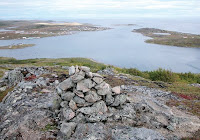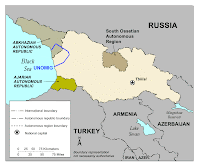It is the summer, so a lot of the news papers take this rare chance to talk about the Basque Country without referring to the political conflict, which is a welcomed relief. Yesterday I posted about traveling from England to Euskal Herria by ferry, well, today is time to pay a quick visit to Biarritz thanks to The New York Times:
36 Hours in Biarritz
By KABIR CHIBBER
Published: August 31, 2008
THE glitz may have migrated to the French Riviera, but Biarritz doesn’t need it. The posh seaside town in southwest France is enjoying a renaissance, as people discover the appeal of this aristocratic resort on the Bay of Biscay where worlds collide and expectations are upended. Once the reigning vacation spot for Europe’s noble and gentry classes, Biarritz’s golden shores are now shared by everyone from bronze beauties in designer sandals to drop-out surfers in frayed flip-flops. Even the languages are mixed up. Walk into any of the town’s creaky old bars, and the patrons might strike up a conservation by saying a few words in rapid-fire French, Spanish, English or even Basque, the local language that, like the resort, is in a class by itself.
Friday
5 p.m.
1) THE BEAUTIFUL PEOPLE
Biarritz is a tale of two beaches, so start by getting acquainted with the Grande Plage, a curved stretch of golden sand dotted with brightly colored parasols. Buy a gelato from La Passion des Fruits and watch the impossibly pretty young things in oversized Christian Dior shades flirt for hours in the blazing sun. Farther down the beach, the crowd splits between chic-looking families frolicking in the water, and wealthy 50-year-olds enjoying their early retirement.
9 p.m.
2) DUCK!
Linguists have long been stumped by Basque, a language that bears no relation to Latin or any other European tongue. Hear it shouted at a pelote match, a game similar to handball that’s reputed to be the fastest sport in the world and is played in almost every village. Watch a competitive match, sometime using a curved wooden glove called a xistera, at the Fronton Couvert Plaza Berri.
10:30 p.m
3) LA CôTE BASQUE
Avoid the tourist-trap fish restaurants and head straight for L’Instant in the Port Vieux area, the throbbing historic old town. Be prepared to pass some time: the small restaurant is run entirely by the husband-and-wife team of Jean-Marc and Sylvie Leonhard-Salva. The menu, which changes monthly, features seasonal dishes like baked Basque trout with a light artichoke purée and an almond tart with an ice cream made of cheese. A meal for two, about 70 euros.
Saturday
10 a.m.
4) CAKE WALK
Pick up a gâteau Basque, a small cake filled with a delicious eggy custard, from the posh pâtisserie Loubère. Then head down to the Côte des Basques, a plain beach with rowdy waves where Peter Viertel, a Hollywood screenwriter, introduced surfing to the stunned French more than 50 years ago. Expect to find rows of beat-up vans with makeshift clotheslines parked along the road leading to the sea. There are no changing rooms, so be prepared to shed your modesty or practice changing underneath a towel.
11 a.m.
5) ÉCOLE DU SURF
If you’re prone to wiping out, track down Jean-Baptiste, the true-blue dude at the beach’s sole surf shop, BTZ Clothing. He’ll set you up with a lesson at Hastea, a professional surfing school, and BTZ’s owner. Ninety-minute lessons with the gruff-but-friendly instructors run 35 euros per person for a group session. And don’t worry about all the small jellyfish in the water. They don’t sting ...much.
1 p.m.
6) RECHARGE
Walk straight up from the shore to Le Surfing, the coziest of the two bars on this undeveloped stretch of coast. It may be the most casual place in Biarritz, with groovy boards, black-and-white surf posters and friendly employees who don’t mind if you’re dripping water everywhere. Order the brandade de morue, a sort of purée of salt cod, or the hefty rib-eye steak.
4 p.m.
7) FASHION VICTIM
As the day progresses, the unspoken dress code goes from beach bum to Diddy and Donatella. Pay a visit to 64, a fashion label that has several stylish stores on Biarritz’s most fashionable street, including ones for beachwear and children, and was set up by local designers. Named for the area code of this département of France, 64 is famous for making T-shirts with the eponymous number in every color. Devotees of the brand collect them all.
8 p.m.
8) FOOD AS ART
With his long hair and air of cockiness, the Ducasse-trained chef Philippe Lafargue may come across as a pretentious rock star. But his restaurant, Chez Philippe serves some of the most exciting nouveau Basque cuisine in the region. Start with an aperitif of Txakoli, a sparkling wine from the Spanish Basque country, and then sample the degustation menu, which features delights like roasted pork loin and sea bass with herbs from the restaurant’s own garden.
11 p.m.
9) BEER-ITZ
People in Biarritz don’t booze, but they certainly know how to unwind. Start with drinks at the Côte Vestiaire. This unassuming little bar, which feels a world away from the masses in the Port Vieux, is packed with rugby shirts hanging from hooks and other memorabilia, a reminder of how proud (and borderline fanatical) everyone here is about the local team, Biarritz Olympique Pays Basque. Strike up a conversation and rest your feet on the quintessential French stool: overturned wine crates.
1 a.m.
10) CLUB WITH A VIEW
Park the Ferrari with the valet and slide into Le Carré Coast, a sleek club that looks out over the beach. Sip vodka cocktails with the sons and daughters of Europe’s elite until the wee hours. Not ready to go home? Just cross the road and sit on the Grande Plage with the other diehards until the sun rises.
Sunday
11 a.m.
11) ONE-STOP SHOP
Pick up goodies at the Halles, a large covered market just off the Rue Gambetta, where getting elbowed by a grandmother who jumps the line is part of the fun. Overwhelmed? Pick up a few slices of the famed Bayonne ham from Didier Carrére’s stall. Then, walk down the road to Mille et Un Fromages, where the moustachioed, fourth-generation owner Henri Bilé sells only the finest in Basque cheeses and wines. Try a Bostmendi, a bright-red liquor made from prunes and sealed in bottles with melted wax.
1 p.m.
12) HISTORY LESSON
It would be heresy to leave Biarritz without meeting Jêrôme Dimitri. He’s an institution, a Serbian who gained fame by photographing celebrities and European royalty in Biarritz’s heyday in the 1960s. His store, Biarritz Photo, is in a back alley, and covered with old photos for sale, as well as pictures and articles about himself. Dimitri doesn’t speak much English, but that won’t stop him from talking about his past, his travels or his children — until you’re called back out to the sea.
.... ... .




